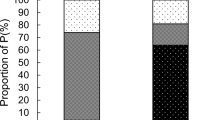Abstract
The effects of soaking seed in 2-chloroethylphosphonic acid (CEPA) for 24 or for 48 h on the cumulative 5-day seedling growth ofCucumis sativus L. (cucumber) andPisum sativum L. (peas) were studied. Each cucumber seed absorbed an average of 0.015 ml of CEPA solution, while pea seed absorbed 0.365 ml, over a 24 h period.
In cucumber, 240 mg l−1 CEPA concentration decreased radicle length by 23%, regardless of soaking duration. The same concentration increased radicle weight in a 24 h soaking duration, but decreased radicle weight when soaking was for 48 h. At 48 h, CEPA concentrations of 0.24 and 2.4 mg l−1 increased plumule growth by 26%. In peas, the 240 mg l−1 decreased the length and the weight of both the radicle and the plumule in a 48 h soaking duration, but had no significant effect at a 24 h soaking. At the low concentration of 0.24 mg l−1, seedling growth was stimulated by over 30%.
Cucumber was 3 times more efficient than peas in the utilization of CEPA for seedling growth, in terms of total fresh weight of seedling per microgram of CEPA absorbed: 1 127 and 274 mg μg−1 CEPA in cucumber and peas respectively. Extrapolative calculation, using cucumber responses as standard, suggests from this seedling study that about 12 mg l−1 CEPA is likely to stimulate growth and/or yield in sprayed pea plants.
Abstract
Byl sledován vliv máčení semen v kyselině 2-chlorethylfosfonové (CEPA) během 24 nebo 48 h na celkový růst pětidenních klíčních rostlin okurky a hrachu. Během 24 h absorbovalo každé semeno okurky průměrně 0,015 ml roztoku CEPA, zatímeo hrách absorboval 0,365 ml.
Koncentrace 240 mg l−1 CEPA snížila růst kořínku okurky o 23%, bez ohledu na dobu máčení. Při 24 h máčení stejná koncentrace CEPA zvýšila váhu kořínku, zatímco při 48 h máčení byla váha kořínku nižší. Po 48 h, 0,24 a 2,4 mg l−1 koncentrace CEPA zvýšila růst plumuly o 26%. Při 48 h máčení 240 mg l−1 koncentrace CEPA zmenšuje jak délku, tak i váhu kořínku i plumuly hrachu, ale nemá průkazný vliv při 24 h máčení. Při nízké koncentraci 0,24 mg l−1 CEPA byl růst klíčních rostlin stimulován o více než 30%.
Vyjádřeno v celkové čerstvé váze rostliny na mikrogram absorbované CEPA, je využití CEPA pro růst klíčních rostlin okurky 3krát vyšší než u hrachu: u okurky 1127, u hrachu 274 mg μg−1. Vezmeme-li reakci okurky za standard, extrapolace výsledků ukazuje, že růst a nebo výnos hrachu je nejspíše stimulován koncentrací asi 12 mg l−1 CEPA.
Similar content being viewed by others
References
Adedipe, N. O.: Effects of 2-chloroethylphosphonic acid on growth, plastid pigments, and sucrose translocation in radish.—J. exp. Bot.24: 124–129, 1973.
Adedipe, N. O., Ormrod, D. P.: Vegetative growth responses of pea plants to CCC and Phosfon in relation to phosphorus nutrition.—J. exp. Bot.23: 842–848, 1972.
McMurray, A. L., Miller, C. H.: The effect of 2-chloroethylphosphonic acid (Ethre!) on the sex expression and yields ofCucumis sativus.—J. amer. Soc. hort. Sci.94: 400–402, 1969.
Miller, C. H., Lower, R. L., McMurray, A. L.: Some effects of Ethrel (2-chloroethylphosphonic acid) on vegetable crops.—Hort. Sci.4: 248–249, 1969.
Ram, H. Y. M., Jaismal, V. S.: Induction of female flowers on male plants ofCannabis sativa by 2-chloroethylphosphonic acid.—Experientia26: 214–216, 1970.
Rudich, J., Halevy, A. H., Kedar, N.: Increase in femaleness of 3 cucurbits by treatment with ethrel, an ethylene releasing compound.—Planta86: 69–76, 1969.
Sankhla, N., Sankhla, D.: Lettuce seed germination: interaction between auxin and 2-chloroethylphosphonic acid (Ethrel).—Biol. Plant.14: 321–324, 1972.
Sankhla, N., Shukhla, S. N.: Observations on hypocotyl coiling: Effect of ethrel and gibberellin on seedling growth ofPhaseolus radiatus.—Z. Pflanzenphysiol.63: 284–287, 1970.
Warner, H. L., Leopold, A. C.: Plant growth regulation by stimulation of ethylene production. —BioScience17: 722, 1967.
de Wilde, R. C.: Practical application of 2-chloroethylphosphonic acid in agricultural production. —Hort. Sci.6: 364–370, 1971.
Author information
Authors and Affiliations
Rights and permissions
About this article
Cite this article
Adedipe, N.O. Kinetics and implications of seedling growth responses to 2-chloroethylphosphonic acid. Biol Plant 17, 55–59 (1975). https://doi.org/10.1007/BF02921075
Received:
Published:
Issue Date:
DOI: https://doi.org/10.1007/BF02921075




